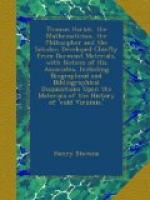In this way De Bry was induced to make Hariot’s Virginia the First Part of his celebrated PEREGRINATIONS, with a dedication to Sir Walter Raleigh. Florida then became the Second Part. The first was illustrated from the portfolio of John White, and the second from that of Jaques Le Moyne. Both parts are therefore perfectly authentic and trustworthy. Thus the famous Collections of De Bry may be said to be of English origin, for to Raleigh and his magi De Bry owed everything in the start of his great work. Being thus supplied and instructed, De Bry returned to Frankfort, and with incredible energy and enterprise, engraved, printed, and issued his VIRGINIA in four languages, English, French, Latin and German, in 1590, and his Florida in Latin and German, in 1591. The bibliographical history of these books, the intimacy and dependence of the several persons engaged; and the geographical development of Florida-Virginia are all so intertwined and blended, that the whole seems to lead up to Thomas Hariot, the clearing up of whose biography thus becomes an appropriate labor of the Hercules Club.
Little more remains to be said of Raleigh’s Magi who have been thus shown to be hand and glove in working out these interesting episodes of French and English colonial history. To Hakluyt, Le Moyne, White, De Bry and Hariot, Raleigh owes an undivided and indivisible debt of gratitude for the prominent niche which he achieved in the world’s history, especially in that of England and America ; while to Raleigh’s liberal heart and boundless enterprise must be ascribed a generous share of the reputation achieved by his Magi in both hemispheres.
Of Hakluyt and De Bry little more need be said here. They both hewed out their own fortunes and recorded them on the pages of history, the one with his pen, the other with his graver. If at times ill informed bibliographers who have got beyond their depth fail to discern its merits, and endeavour to deny or depreciate De Bry’s Collection, charging it with a want of authenticity and historic truth, it is hoped that enough has been said here to vindicate at least the first two parts, Virginia and Florida. The remaining parts, it is believed, can be shown to be of equal authority.
Whoever compares the original drawings of Le Moyne and White with the engravings of De Bry, as one may now do in the British Museum, must be convinced that, beautiful as De Bry’s work is, it seems tame in the presence of the original water-colour drawings. There is no exaggeration in the engravings.
Le Moyne’s name has not found its way into modern dictionaries of art or biography, but he was manifestly an artist of great merit and a man of good position. In addition to what is given above it may be added that a considerable number of his works is still in existence, and it is hoped will hereafter be duly appreciated. In the print-room of the British Museum are two of his drawings, highly finished in




